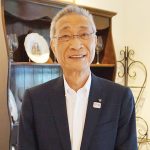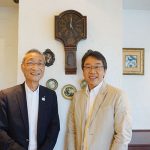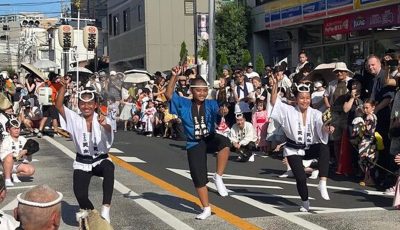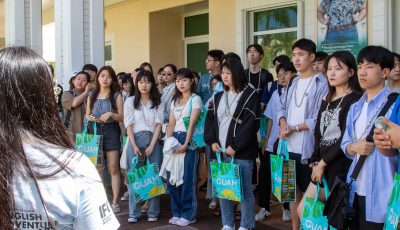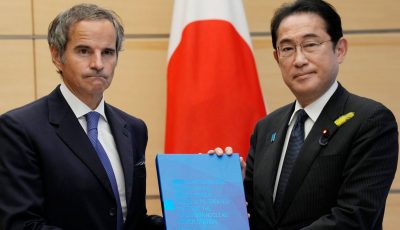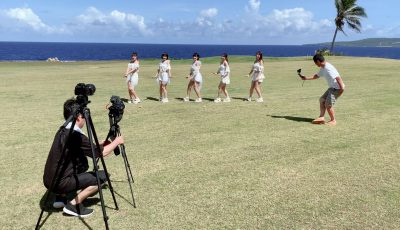Shepherding the PAL program for more than 32 years
- Yasuo Miyasawa, the founder and CEO of Seisa Group. (Bea Cabrera)
- Yasuo Miyasawa, the founder and CEO of Seisa Group, is joined by Hajime Inuoe, chief operating officer of the Seisa Group. (Bea Cabrera)
As a young person, Hajime Inuoe, the current chief operating officer of the Seisa Group, was himself a participant of the group’s Participate and Learn program many years ago.
As a student of the Seisa High School in Japan, that experience brought him to Saipan a long time ago and exposed him to the value of the program and brought him within the sphere of influence of Yasuo Miyasawa, the founder and CEO of Seisa Group.
“If I had no influence from him, I might be a typical Japanese doing job for the money only. At Seisa, we are working for the future to make the world brighter. A normal Japanese would be working to…have a better vehicle, a big house and those are good reasons,” Inoue said. “Miyazawa’s influence is be a good person, learn, educate, explore, reach out so you can help others achieve the same. These are the true riches of life.”
For the last 32 years, the Seisa Group has been bringing Seisa High School students from Japan to Saipan to learn, explore, and build relationships under the PAL program’s three principles: understanding each other, leaving nobody out and making friends. These principles are integrated in the studies and exchange programs between Saipan and Japanese students who take part in the program.
Miyasawa himself first came to the CNMI in 1985. He saw the beauty of Saipan and, with it, the opportunity for his Japanese students to expand education beyond the four walls of a classroom.
“The PAL program began with the help and guidance of Bert Thompson and his wife Doris, with whom I was very good friends with in Guam. When Bert transferred to Saipan and became the principal of Marianas High School, I went to visit them and [learned that] Saipan and Japan have a long history of war and battles,” he said.
“Bert and I talked and we immediately decided that we can learn more about our past, present and future if we have a program where Saipan and Japanese students can participate, cultivate peace and work together. I am proud to say that it has been 32 years since,” he added.
Miyazawa said the Seisa Group started with a very small program and it was difficult explaining to Saipan schools why a PAL program is important.
“At that time teachers and students of MHS did not understand the importance and significance of this program. Bert and Doris tried to show them the urgency and importance of the program. It is one that will be very good for students and that something must be done,” he said
“At that time, Bert had lessons for vocational training where he took in Seisa students and put them into the vocational learning here. They did not speak English at all but they tried to communicate,” he added.
From there, the small group slowly grew, learning and building relationships.
“The process was akin to a dance where you slowly get the steps and slowly understands its importance. Our students who were not used to traveling and being with different people were so happy to meet new friends and build on that relationship,” he said.
He recalled that it was former MHS principal Vic Cepeda who further opened the door for the program to flourish to what it is today.
“I would get asked, ‘Why Saipan?’ I tell them it is because the people here are warm, open-minded and welcoming to our students. Some of our students had one-track minds and others were very shy. In the end, our students returned to Japan, bringing with them the warmth and cherished friendships they made because the program break barriers,” he added.
Miyazawa says the PAL program is not just a sightseeing tour. Students meticulously study the history of Saipan and Japan before they get here.
“Our students study the history between Saipan and Japan, Saipan and U.S., and Japan and U.S. so that they learn deeply. Seisa students learn the culture and history of Saipan, including the war and peace that world wars brought into the islands,” he said.
“MHS holds a Cultural Day for our students so they can be exposed, build friendships and nurture the experience. This is a good way to really understand the differences of each other,” he added.
One of the highlights of the PAL program is the exchange program, where Saipan students get to visit Japan and vice versa to know more about day-to-day living.
“I remember the first Saipan students that visited Japan belonged to families with different socio-economic background and, because of that, you know there are barriers within the group. However, after spending 10 days in Japan, the relationship changed; they found that the difference is nothing when you understand each other,” Miyazawa said.
“The result is the same with our Japanese students. They become less scared, less selfish, and come out of it amazed. Over the years and with the PAL program experience, we have former students who became doctors, attorneys and one even became a member of the parliament,” he added.
Miyazawa, who is almost 70 years old, is passing the baton to Inuoe.
Before becoming an educator and founder/CEO of Seisa Group, Miyazawa’s childhood dream was to be a cowboy.
“I was a fan of the American TV show Rawhide where the story revolved on bringing cows and traveling 3,000 kilometers from west to east and there were many accidents and events along the way but cooperation was key to reaching their destination,” he said.
“My friends wanted to be a doctor, an astronaut, and I was the only one who wanted to be cowboy. It did not come true, obviously, but yes, that was my childhood dream.”
Although he did not become a cowboy, Miyazawa’s experience of bringing students from Japan to Saipan and vice versa to learn and have a better perspective about people and the world is like the story of the cowboy leading his herd to a better place.
“Students come to me and say, ‘Kaicho’ (chairman in Japanese), thank you very much. They say, “I enjoyed the program and I learned that I could make friends with Saipan people and know more about the world. I now have the courage to change my situation and please watch me, kaicho.’ Those times are my happiest moments. I know these students, their families and backgrounds and the thought that I helped touch their lives is something else.”
Miyazawa, who plans to retire soon, considers the PAL program not a school or a business matter but the legacy of his life.



